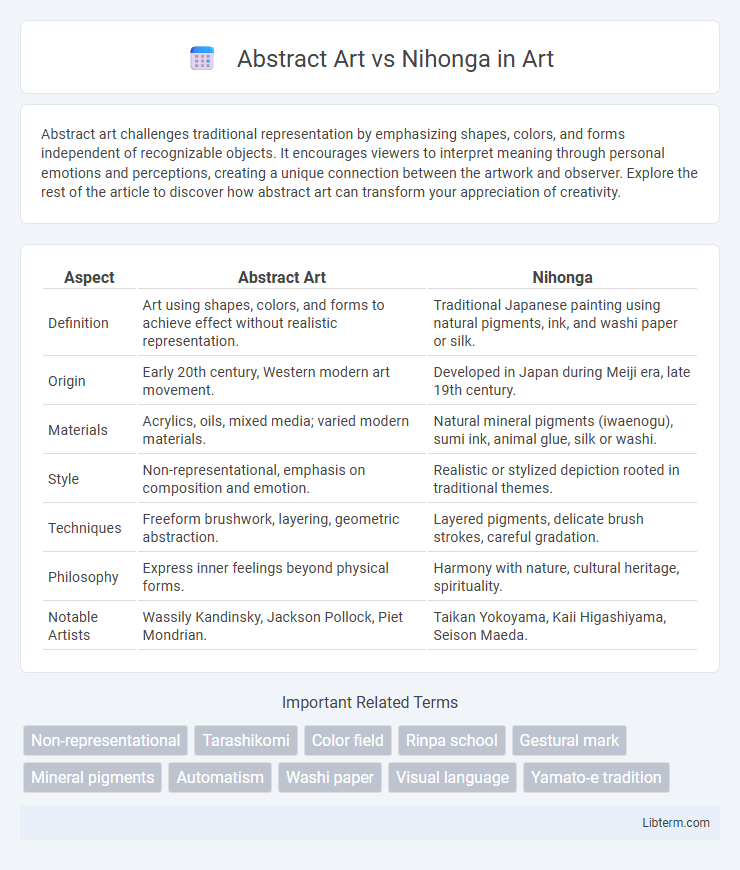Abstract art challenges traditional representation by emphasizing shapes, colors, and forms independent of recognizable objects. It encourages viewers to interpret meaning through personal emotions and perceptions, creating a unique connection between the artwork and observer. Explore the rest of the article to discover how abstract art can transform your appreciation of creativity.
Table of Comparison
| Aspect | Abstract Art | Nihonga |
|---|---|---|
| Definition | Art using shapes, colors, and forms to achieve effect without realistic representation. | Traditional Japanese painting using natural pigments, ink, and washi paper or silk. |
| Origin | Early 20th century, Western modern art movement. | Developed in Japan during Meiji era, late 19th century. |
| Materials | Acrylics, oils, mixed media; varied modern materials. | Natural mineral pigments (iwaenogu), sumi ink, animal glue, silk or washi. |
| Style | Non-representational, emphasis on composition and emotion. | Realistic or stylized depiction rooted in traditional themes. |
| Techniques | Freeform brushwork, layering, geometric abstraction. | Layered pigments, delicate brush strokes, careful gradation. |
| Philosophy | Express inner feelings beyond physical forms. | Harmony with nature, cultural heritage, spirituality. |
| Notable Artists | Wassily Kandinsky, Jackson Pollock, Piet Mondrian. | Taikan Yokoyama, Kaii Higashiyama, Seison Maeda. |
Introduction to Abstract Art and Nihonga
Abstract Art emphasizes non-representational forms, focusing on shapes, colors, and textures to evoke emotions and ideas beyond realistic depiction. Nihonga, a traditional Japanese painting style, combines natural pigments and mineral-based materials on paper or silk, preserving cultural and historical themes with meticulous brushwork. Both art forms explore expression and aesthetics but diverge fundamentally in technique, materials, and philosophical underpinnings.
Historical Origins and Evolution
Abstract art emerged in the early 20th century, rooted in Western avant-garde movements like Cubism and Expressionism, emphasizing non-representational forms to evoke emotions beyond literal depictions. Nihonga, developed in late 19th-century Japan, revitalizes traditional Japanese painting techniques while incorporating select Western influences, maintaining a focus on natural themes and cultural symbolism. Both styles reflect distinct cultural responses to modernization, with abstract art prioritizing innovation and Nihonga seeking harmony between tradition and change.
Philosophical Foundations and Artistic Intent
Abstract Art emphasizes individual expression and the exploration of non-representational forms, rooted in Western modernist philosophies that prioritize subjective experience and emotional resonance. Nihonga, grounded in traditional Japanese aesthetics, reflects a harmonious balance between nature, spirituality, and cultural heritage, anchored in principles like wabi-sabi and the reverence for impermanence. The artistic intent in Abstract Art seeks to challenge visual perception and evoke personal interpretation, while Nihonga aims to preserve and reinterpret classical techniques to convey timeless beauty and philosophical depth.
Key Techniques and Materials
Abstract Art emphasizes spontaneous brushstrokes, vibrant color fields, and unconventional materials such as acrylics, mixed media, and synthetic pigments to convey emotion and movement. Nihonga relies on traditional natural pigments like mineral-based colors, sumi ink, and animal glue, applied on washi paper or silk using precise layering and meticulous brush techniques. Both styles prioritize texture and composition, but Abstract Art embraces experimentation, while Nihonga upholds classical methods rooted in Japanese aesthetics.
Iconic Artists and Influential Works
Abstract Art features pioneers like Wassily Kandinsky and Jackson Pollock, whose works such as "Composition VII" and "No. 5, 1948" revolutionized non-representational forms through dynamic shapes and energetic brushstrokes. Nihonga, rooted in traditional Japanese techniques, showcases artists like Yokoyama Taikan and Kaii Higashiyama, with masterpieces including "Yugure" and "Autumn Mountains," emphasizing natural beauty and subtle tonal gradations using mineral pigments on silk or paper. The contrast between Abstract Art's expressive abstraction and Nihonga's refined realism highlights divergent cultural approaches to form and aesthetics.
Color, Composition, and Symbolism
Abstract Art emphasizes bold, dynamic colors and asymmetrical compositions that evoke emotional responses through non-representational forms, often exploring themes of chaos and spontaneity. Nihonga uses natural pigments and delicate layering techniques to create balanced compositions inspired by traditional Japanese aesthetics, integrating symbolic elements such as flora, fauna, and seasonal motifs to convey cultural narratives. The symbolism in Abstract Art is subjective and open to interpretation, whereas Nihonga employs established icons deeply rooted in historical and spiritual contexts.
Cultural Context and Identity
Abstract art challenges traditional representation, emphasizing individual expression and modernist perspectives that often reflect globalized cultural shifts and personal identity exploration. Nihonga, rooted in centuries-old Japanese techniques and aesthetics, embodies cultural continuity and national identity, preserving indigenous materials, symbolism, and spiritual connections to nature. This contrast highlights how Abstract art aligns with evolving, global identities, while Nihonga reaffirms cultural heritage and historical consciousness.
Methods of Interpretation and Appreciation
Abstract Art emphasizes subjective interpretation through color, form, and texture, encouraging viewers to derive personal meaning beyond representational content. Nihonga adheres to traditional Japanese techniques and symbolism, inviting appreciation of its cultural context, craftsmanship, and natural motifs. Understanding Nihonga involves recognizing its connection to heritage and nature, while Abstract Art challenges conventional perspectives by prioritizing emotional resonance and individual experience.
Global Influence and Contemporary Trends
Abstract Art, with its roots in the early 20th century Western avant-garde, emphasizes non-representational forms and has significantly shaped global contemporary art trends through its embrace of spontaneity and emotional expression. Nihonga, a traditional Japanese painting style using natural pigments and materials, has experienced a resurgence by integrating modern themes while preserving its cultural techniques, influencing both Asian and international art markets. Contemporary trends show Abstract Art expanding into digital and mixed media platforms, whereas Nihonga artists innovate by blending traditional aesthetics with contemporary narratives, fostering cross-cultural artistic dialogues worldwide.
Abstract Art vs Nihonga: Comparative Analysis
Abstract Art emphasizes non-representational forms, color, and emotion, prioritizing creativity and subjective interpretation. Nihonga, rooted in traditional Japanese techniques, incorporates natural pigments and themes inspired by nature and classical aesthetics. Comparing Abstract Art and Nihonga reveals contrasting approaches: modern Western abstraction versus the preservation of cultural heritage and meticulous craftsmanship in Nihonga.
Abstract Art Infographic

 libterm.com
libterm.com